Business Law Assignment: Analysis of Legal Cases and Contract Issues
VerifiedAdded on 2023/01/23
|8
|2240
|36
Homework Assignment
AI Summary
This document presents a comprehensive solution to a business law assignment, addressing key concepts in contract law, negligence, and related legal principles. The assignment explores various scenarios, including contract formation, breach of contract, and the application of promissory estoppel. It analyzes cases involving employment contracts, exclusion clauses, and the Goods Act, providing detailed answers to problem questions. The document examines the legal implications of loan agreements, broken promises, and negligence in parking areas, offering insights into the rights and responsibilities of parties involved. Furthermore, it delves into the distinction between terms and representations in contract formation, supported by relevant case law. The solution also provides a reference list of legal cases and scholarly articles to support the arguments presented, making it a valuable resource for students studying business law.
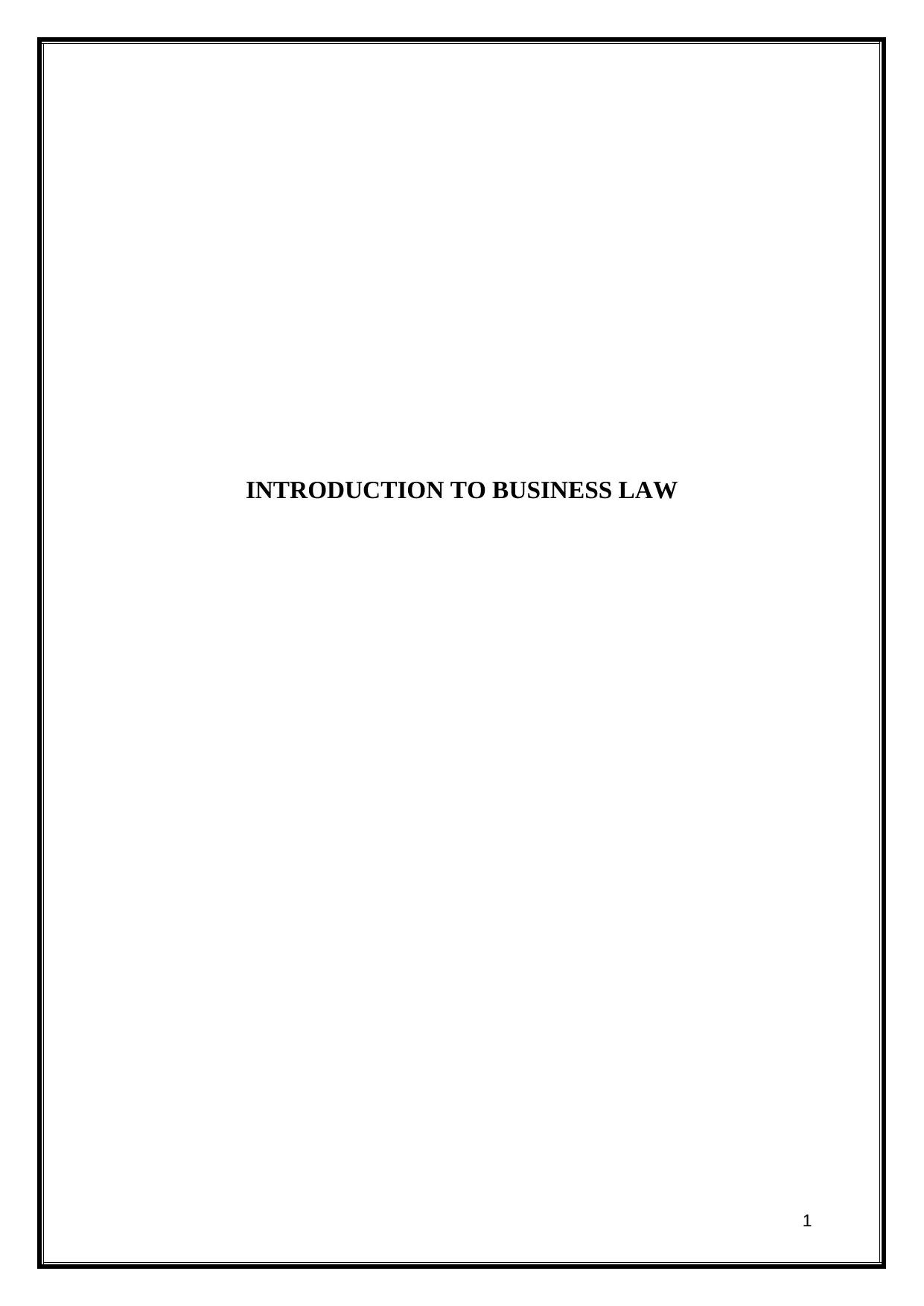
INTRODUCTION TO BUSINESS LAW
1
1
Paraphrase This Document
Need a fresh take? Get an instant paraphrase of this document with our AI Paraphraser
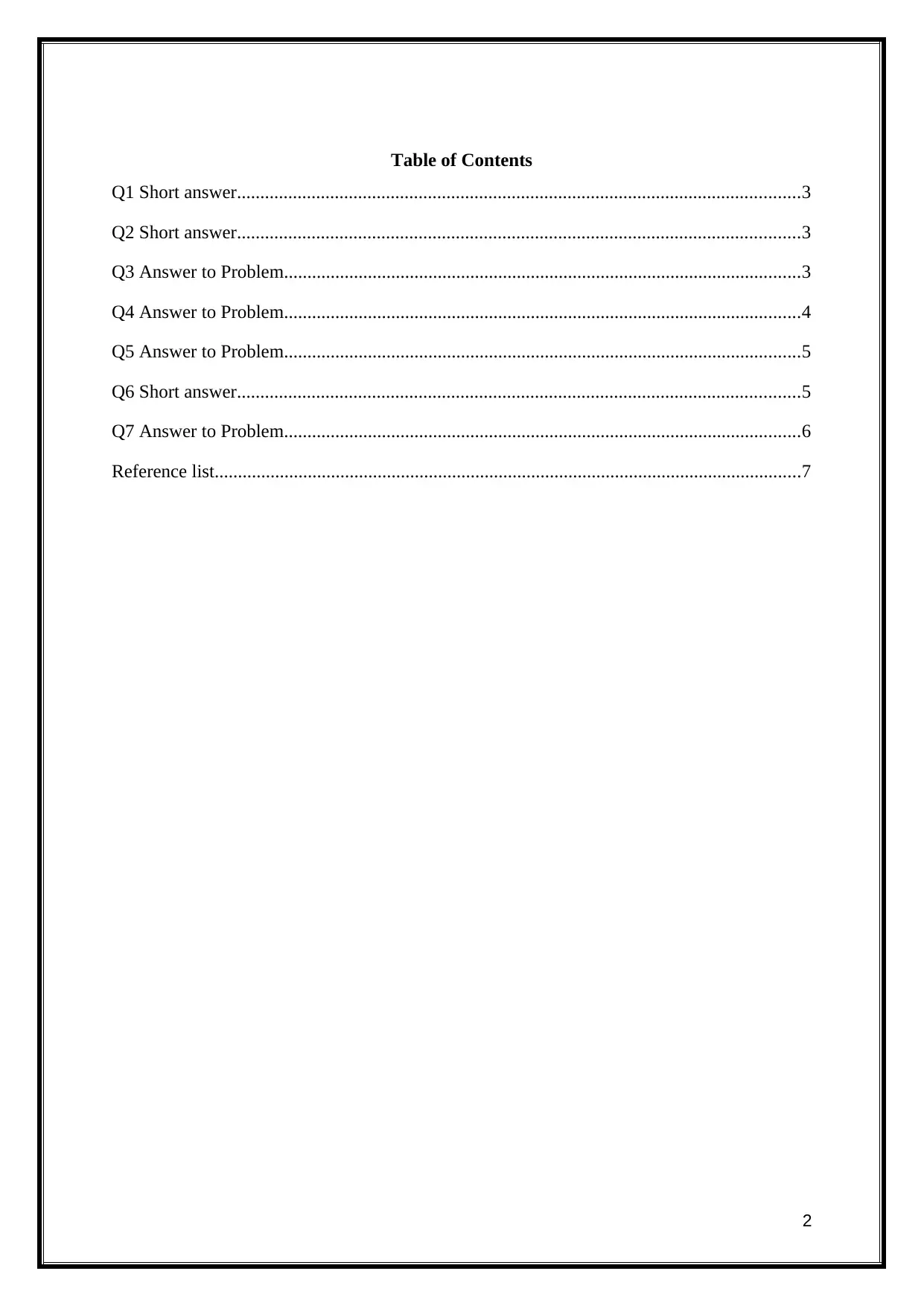
Table of Contents
Q1 Short answer.........................................................................................................................3
Q2 Short answer.........................................................................................................................3
Q3 Answer to Problem...............................................................................................................3
Q4 Answer to Problem...............................................................................................................4
Q5 Answer to Problem...............................................................................................................5
Q6 Short answer.........................................................................................................................5
Q7 Answer to Problem...............................................................................................................6
Reference list..............................................................................................................................7
2
Q1 Short answer.........................................................................................................................3
Q2 Short answer.........................................................................................................................3
Q3 Answer to Problem...............................................................................................................3
Q4 Answer to Problem...............................................................................................................4
Q5 Answer to Problem...............................................................................................................5
Q6 Short answer.........................................................................................................................5
Q7 Answer to Problem...............................................................................................................6
Reference list..............................................................................................................................7
2
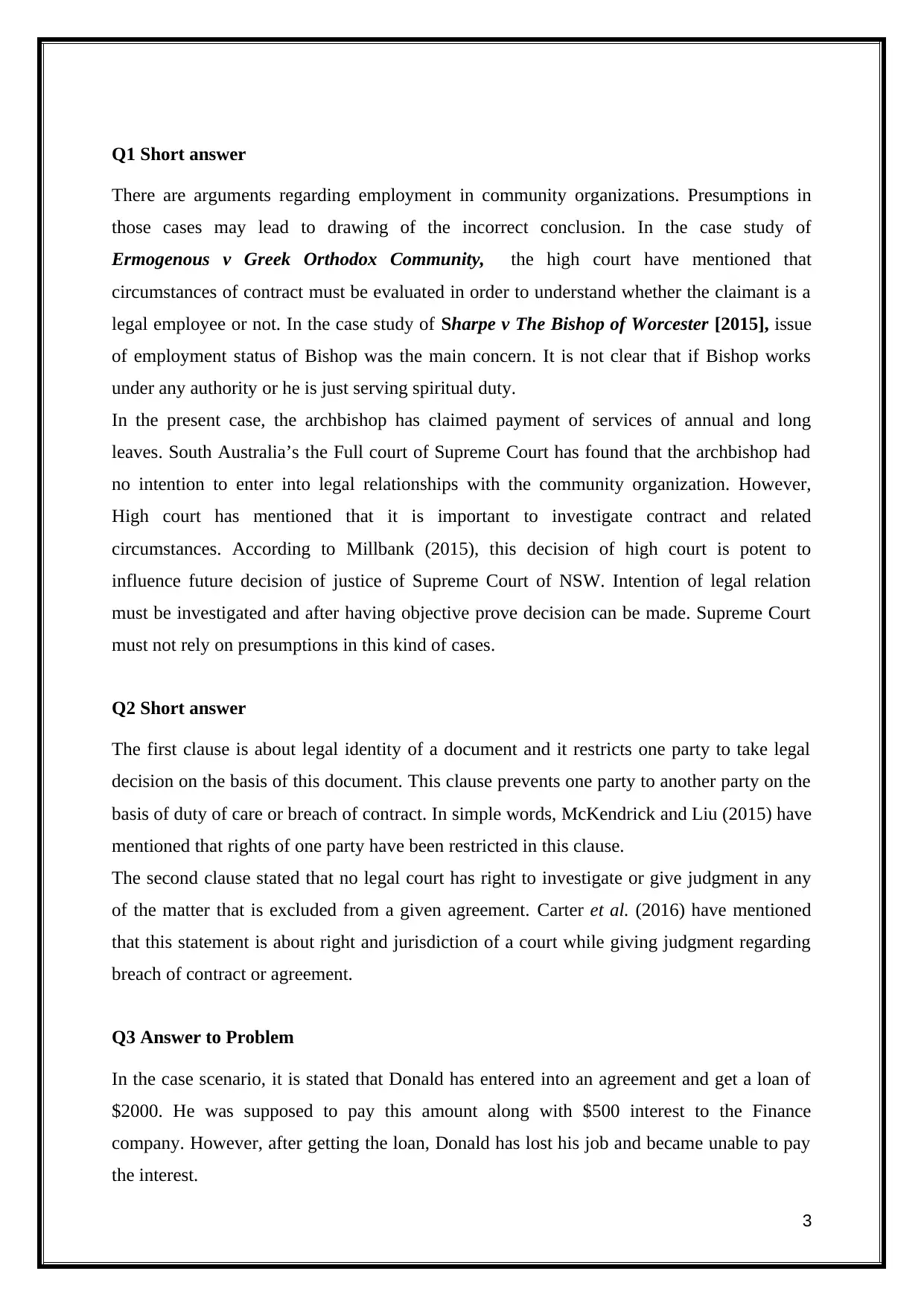
Q1 Short answer
There are arguments regarding employment in community organizations. Presumptions in
those cases may lead to drawing of the incorrect conclusion. In the case study of
Ermogenous v Greek Orthodox Community, the high court have mentioned that
circumstances of contract must be evaluated in order to understand whether the claimant is a
legal employee or not. In the case study of Sharpe v The Bishop of Worcester [2015], issue
of employment status of Bishop was the main concern. It is not clear that if Bishop works
under any authority or he is just serving spiritual duty.
In the present case, the archbishop has claimed payment of services of annual and long
leaves. South Australia’s the Full court of Supreme Court has found that the archbishop had
no intention to enter into legal relationships with the community organization. However,
High court has mentioned that it is important to investigate contract and related
circumstances. According to Millbank (2015), this decision of high court is potent to
influence future decision of justice of Supreme Court of NSW. Intention of legal relation
must be investigated and after having objective prove decision can be made. Supreme Court
must not rely on presumptions in this kind of cases.
Q2 Short answer
The first clause is about legal identity of a document and it restricts one party to take legal
decision on the basis of this document. This clause prevents one party to another party on the
basis of duty of care or breach of contract. In simple words, McKendrick and Liu (2015) have
mentioned that rights of one party have been restricted in this clause.
The second clause stated that no legal court has right to investigate or give judgment in any
of the matter that is excluded from a given agreement. Carter et al. (2016) have mentioned
that this statement is about right and jurisdiction of a court while giving judgment regarding
breach of contract or agreement.
Q3 Answer to Problem
In the case scenario, it is stated that Donald has entered into an agreement and get a loan of
$2000. He was supposed to pay this amount along with $500 interest to the Finance
company. However, after getting the loan, Donald has lost his job and became unable to pay
the interest.
3
There are arguments regarding employment in community organizations. Presumptions in
those cases may lead to drawing of the incorrect conclusion. In the case study of
Ermogenous v Greek Orthodox Community, the high court have mentioned that
circumstances of contract must be evaluated in order to understand whether the claimant is a
legal employee or not. In the case study of Sharpe v The Bishop of Worcester [2015], issue
of employment status of Bishop was the main concern. It is not clear that if Bishop works
under any authority or he is just serving spiritual duty.
In the present case, the archbishop has claimed payment of services of annual and long
leaves. South Australia’s the Full court of Supreme Court has found that the archbishop had
no intention to enter into legal relationships with the community organization. However,
High court has mentioned that it is important to investigate contract and related
circumstances. According to Millbank (2015), this decision of high court is potent to
influence future decision of justice of Supreme Court of NSW. Intention of legal relation
must be investigated and after having objective prove decision can be made. Supreme Court
must not rely on presumptions in this kind of cases.
Q2 Short answer
The first clause is about legal identity of a document and it restricts one party to take legal
decision on the basis of this document. This clause prevents one party to another party on the
basis of duty of care or breach of contract. In simple words, McKendrick and Liu (2015) have
mentioned that rights of one party have been restricted in this clause.
The second clause stated that no legal court has right to investigate or give judgment in any
of the matter that is excluded from a given agreement. Carter et al. (2016) have mentioned
that this statement is about right and jurisdiction of a court while giving judgment regarding
breach of contract or agreement.
Q3 Answer to Problem
In the case scenario, it is stated that Donald has entered into an agreement and get a loan of
$2000. He was supposed to pay this amount along with $500 interest to the Finance
company. However, after getting the loan, Donald has lost his job and became unable to pay
the interest.
3
⊘ This is a preview!⊘
Do you want full access?
Subscribe today to unlock all pages.

Trusted by 1+ million students worldwide
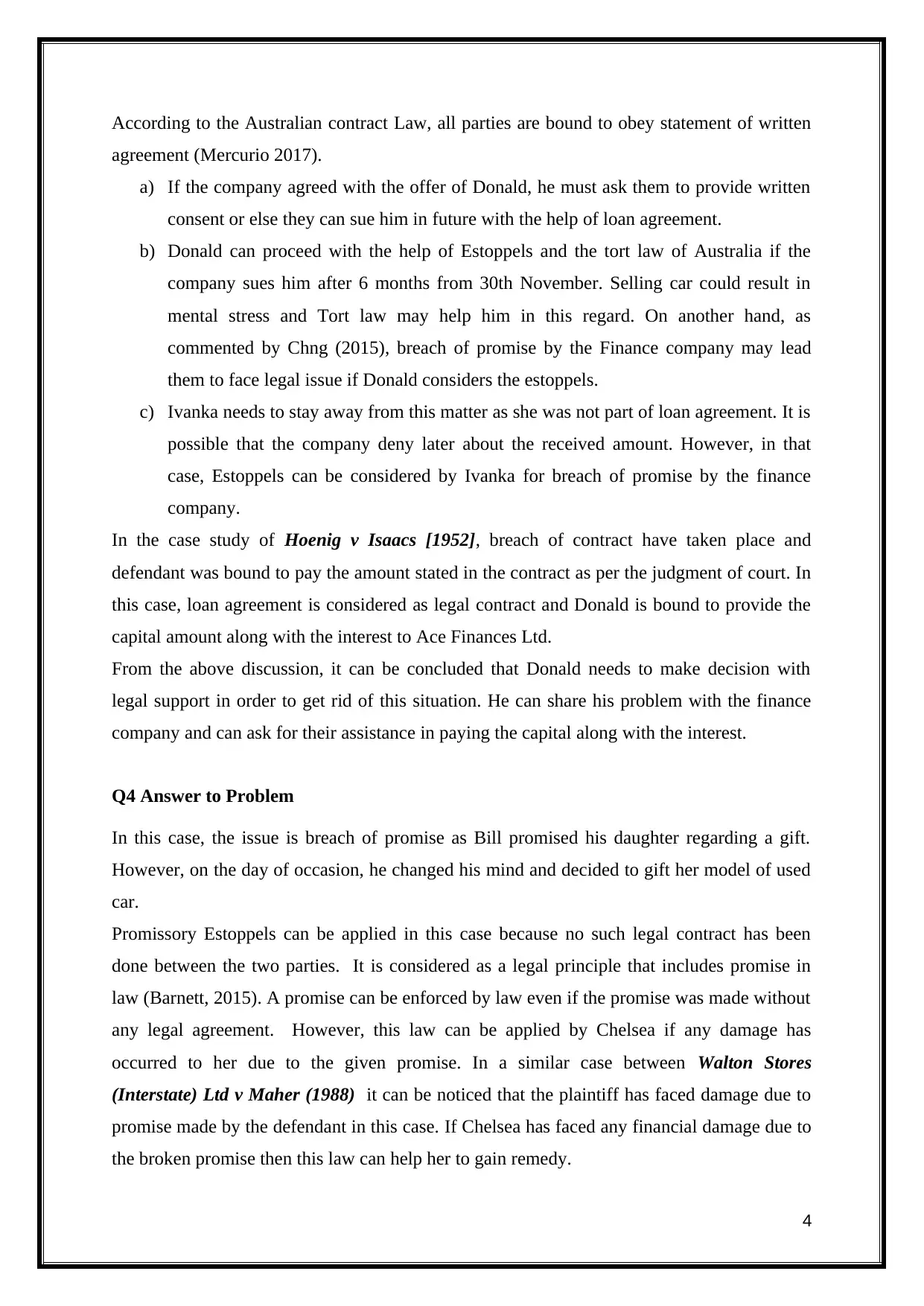
According to the Australian contract Law, all parties are bound to obey statement of written
agreement (Mercurio 2017).
a) If the company agreed with the offer of Donald, he must ask them to provide written
consent or else they can sue him in future with the help of loan agreement.
b) Donald can proceed with the help of Estoppels and the tort law of Australia if the
company sues him after 6 months from 30th November. Selling car could result in
mental stress and Tort law may help him in this regard. On another hand, as
commented by Chng (2015), breach of promise by the Finance company may lead
them to face legal issue if Donald considers the estoppels.
c) Ivanka needs to stay away from this matter as she was not part of loan agreement. It is
possible that the company deny later about the received amount. However, in that
case, Estoppels can be considered by Ivanka for breach of promise by the finance
company.
In the case study of Hoenig v Isaacs [1952], breach of contract have taken place and
defendant was bound to pay the amount stated in the contract as per the judgment of court. In
this case, loan agreement is considered as legal contract and Donald is bound to provide the
capital amount along with the interest to Ace Finances Ltd.
From the above discussion, it can be concluded that Donald needs to make decision with
legal support in order to get rid of this situation. He can share his problem with the finance
company and can ask for their assistance in paying the capital along with the interest.
Q4 Answer to Problem
In this case, the issue is breach of promise as Bill promised his daughter regarding a gift.
However, on the day of occasion, he changed his mind and decided to gift her model of used
car.
Promissory Estoppels can be applied in this case because no such legal contract has been
done between the two parties. It is considered as a legal principle that includes promise in
law (Barnett, 2015). A promise can be enforced by law even if the promise was made without
any legal agreement. However, this law can be applied by Chelsea if any damage has
occurred to her due to the given promise. In a similar case between Walton Stores
(Interstate) Ltd v Maher (1988) it can be noticed that the plaintiff has faced damage due to
promise made by the defendant in this case. If Chelsea has faced any financial damage due to
the broken promise then this law can help her to gain remedy.
4
agreement (Mercurio 2017).
a) If the company agreed with the offer of Donald, he must ask them to provide written
consent or else they can sue him in future with the help of loan agreement.
b) Donald can proceed with the help of Estoppels and the tort law of Australia if the
company sues him after 6 months from 30th November. Selling car could result in
mental stress and Tort law may help him in this regard. On another hand, as
commented by Chng (2015), breach of promise by the Finance company may lead
them to face legal issue if Donald considers the estoppels.
c) Ivanka needs to stay away from this matter as she was not part of loan agreement. It is
possible that the company deny later about the received amount. However, in that
case, Estoppels can be considered by Ivanka for breach of promise by the finance
company.
In the case study of Hoenig v Isaacs [1952], breach of contract have taken place and
defendant was bound to pay the amount stated in the contract as per the judgment of court. In
this case, loan agreement is considered as legal contract and Donald is bound to provide the
capital amount along with the interest to Ace Finances Ltd.
From the above discussion, it can be concluded that Donald needs to make decision with
legal support in order to get rid of this situation. He can share his problem with the finance
company and can ask for their assistance in paying the capital along with the interest.
Q4 Answer to Problem
In this case, the issue is breach of promise as Bill promised his daughter regarding a gift.
However, on the day of occasion, he changed his mind and decided to gift her model of used
car.
Promissory Estoppels can be applied in this case because no such legal contract has been
done between the two parties. It is considered as a legal principle that includes promise in
law (Barnett, 2015). A promise can be enforced by law even if the promise was made without
any legal agreement. However, this law can be applied by Chelsea if any damage has
occurred to her due to the given promise. In a similar case between Walton Stores
(Interstate) Ltd v Maher (1988) it can be noticed that the plaintiff has faced damage due to
promise made by the defendant in this case. If Chelsea has faced any financial damage due to
the broken promise then this law can help her to gain remedy.
4
Paraphrase This Document
Need a fresh take? Get an instant paraphrase of this document with our AI Paraphraser
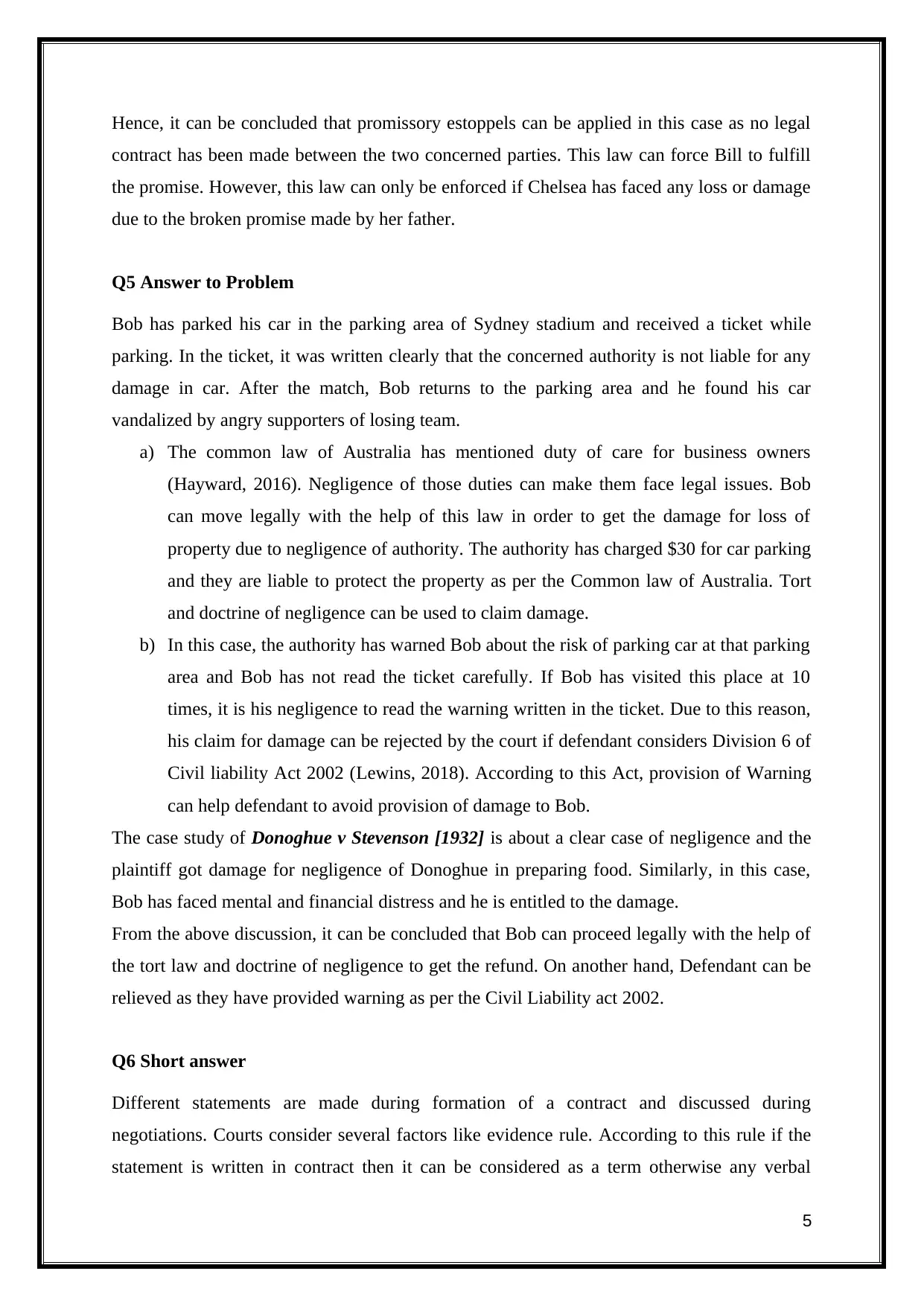
Hence, it can be concluded that promissory estoppels can be applied in this case as no legal
contract has been made between the two concerned parties. This law can force Bill to fulfill
the promise. However, this law can only be enforced if Chelsea has faced any loss or damage
due to the broken promise made by her father.
Q5 Answer to Problem
Bob has parked his car in the parking area of Sydney stadium and received a ticket while
parking. In the ticket, it was written clearly that the concerned authority is not liable for any
damage in car. After the match, Bob returns to the parking area and he found his car
vandalized by angry supporters of losing team.
a) The common law of Australia has mentioned duty of care for business owners
(Hayward, 2016). Negligence of those duties can make them face legal issues. Bob
can move legally with the help of this law in order to get the damage for loss of
property due to negligence of authority. The authority has charged $30 for car parking
and they are liable to protect the property as per the Common law of Australia. Tort
and doctrine of negligence can be used to claim damage.
b) In this case, the authority has warned Bob about the risk of parking car at that parking
area and Bob has not read the ticket carefully. If Bob has visited this place at 10
times, it is his negligence to read the warning written in the ticket. Due to this reason,
his claim for damage can be rejected by the court if defendant considers Division 6 of
Civil liability Act 2002 (Lewins, 2018). According to this Act, provision of Warning
can help defendant to avoid provision of damage to Bob.
The case study of Donoghue v Stevenson [1932] is about a clear case of negligence and the
plaintiff got damage for negligence of Donoghue in preparing food. Similarly, in this case,
Bob has faced mental and financial distress and he is entitled to the damage.
From the above discussion, it can be concluded that Bob can proceed legally with the help of
the tort law and doctrine of negligence to get the refund. On another hand, Defendant can be
relieved as they have provided warning as per the Civil Liability act 2002.
Q6 Short answer
Different statements are made during formation of a contract and discussed during
negotiations. Courts consider several factors like evidence rule. According to this rule if the
statement is written in contract then it can be considered as a term otherwise any verbal
5
contract has been made between the two concerned parties. This law can force Bill to fulfill
the promise. However, this law can only be enforced if Chelsea has faced any loss or damage
due to the broken promise made by her father.
Q5 Answer to Problem
Bob has parked his car in the parking area of Sydney stadium and received a ticket while
parking. In the ticket, it was written clearly that the concerned authority is not liable for any
damage in car. After the match, Bob returns to the parking area and he found his car
vandalized by angry supporters of losing team.
a) The common law of Australia has mentioned duty of care for business owners
(Hayward, 2016). Negligence of those duties can make them face legal issues. Bob
can move legally with the help of this law in order to get the damage for loss of
property due to negligence of authority. The authority has charged $30 for car parking
and they are liable to protect the property as per the Common law of Australia. Tort
and doctrine of negligence can be used to claim damage.
b) In this case, the authority has warned Bob about the risk of parking car at that parking
area and Bob has not read the ticket carefully. If Bob has visited this place at 10
times, it is his negligence to read the warning written in the ticket. Due to this reason,
his claim for damage can be rejected by the court if defendant considers Division 6 of
Civil liability Act 2002 (Lewins, 2018). According to this Act, provision of Warning
can help defendant to avoid provision of damage to Bob.
The case study of Donoghue v Stevenson [1932] is about a clear case of negligence and the
plaintiff got damage for negligence of Donoghue in preparing food. Similarly, in this case,
Bob has faced mental and financial distress and he is entitled to the damage.
From the above discussion, it can be concluded that Bob can proceed legally with the help of
the tort law and doctrine of negligence to get the refund. On another hand, Defendant can be
relieved as they have provided warning as per the Civil Liability act 2002.
Q6 Short answer
Different statements are made during formation of a contract and discussed during
negotiations. Courts consider several factors like evidence rule. According to this rule if the
statement is written in contract then it can be considered as a term otherwise any verbal
5
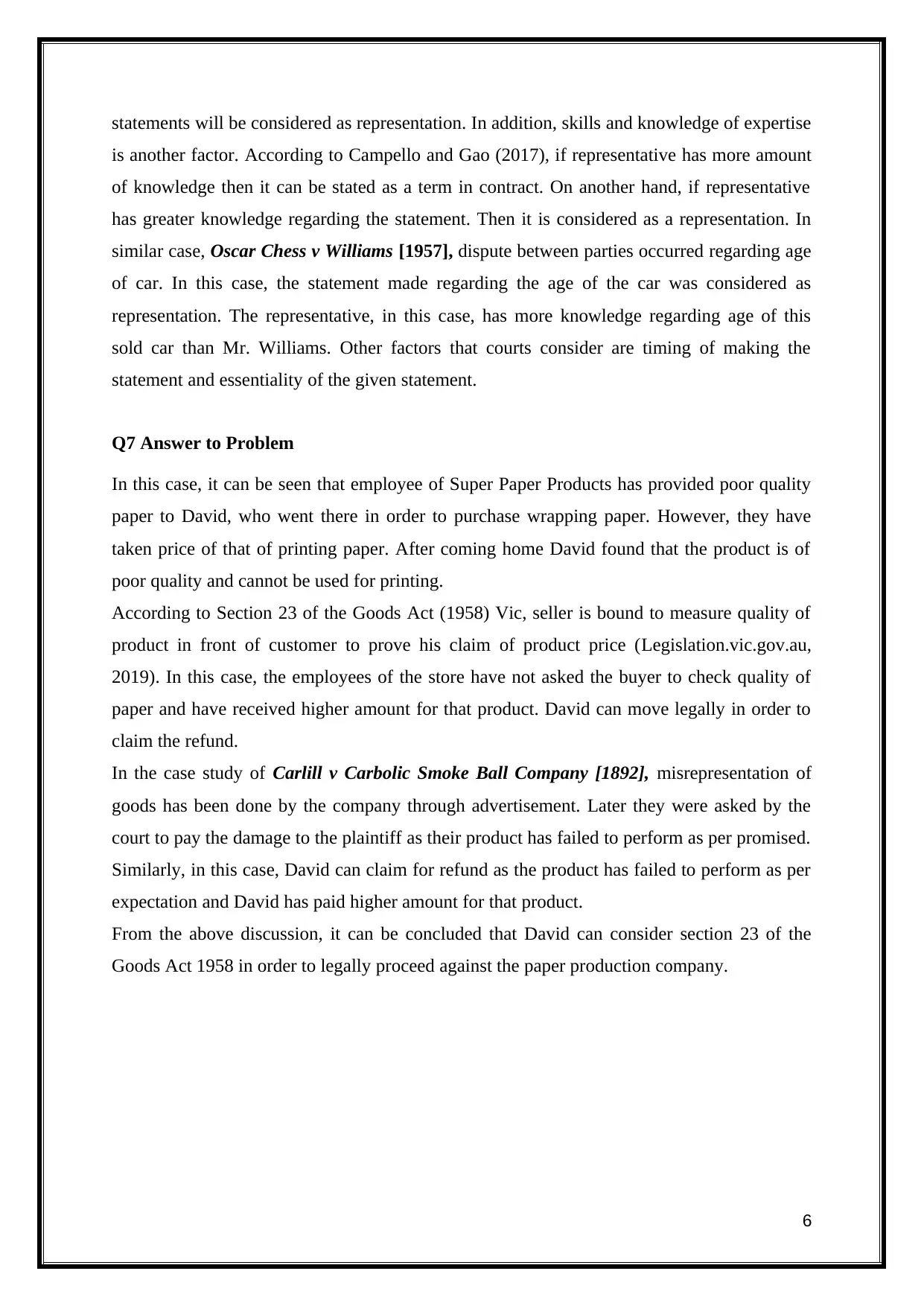
statements will be considered as representation. In addition, skills and knowledge of expertise
is another factor. According to Campello and Gao (2017), if representative has more amount
of knowledge then it can be stated as a term in contract. On another hand, if representative
has greater knowledge regarding the statement. Then it is considered as a representation. In
similar case, Oscar Chess v Williams [1957], dispute between parties occurred regarding age
of car. In this case, the statement made regarding the age of the car was considered as
representation. The representative, in this case, has more knowledge regarding age of this
sold car than Mr. Williams. Other factors that courts consider are timing of making the
statement and essentiality of the given statement.
Q7 Answer to Problem
In this case, it can be seen that employee of Super Paper Products has provided poor quality
paper to David, who went there in order to purchase wrapping paper. However, they have
taken price of that of printing paper. After coming home David found that the product is of
poor quality and cannot be used for printing.
According to Section 23 of the Goods Act (1958) Vic, seller is bound to measure quality of
product in front of customer to prove his claim of product price (Legislation.vic.gov.au,
2019). In this case, the employees of the store have not asked the buyer to check quality of
paper and have received higher amount for that product. David can move legally in order to
claim the refund.
In the case study of Carlill v Carbolic Smoke Ball Company [1892], misrepresentation of
goods has been done by the company through advertisement. Later they were asked by the
court to pay the damage to the plaintiff as their product has failed to perform as per promised.
Similarly, in this case, David can claim for refund as the product has failed to perform as per
expectation and David has paid higher amount for that product.
From the above discussion, it can be concluded that David can consider section 23 of the
Goods Act 1958 in order to legally proceed against the paper production company.
6
is another factor. According to Campello and Gao (2017), if representative has more amount
of knowledge then it can be stated as a term in contract. On another hand, if representative
has greater knowledge regarding the statement. Then it is considered as a representation. In
similar case, Oscar Chess v Williams [1957], dispute between parties occurred regarding age
of car. In this case, the statement made regarding the age of the car was considered as
representation. The representative, in this case, has more knowledge regarding age of this
sold car than Mr. Williams. Other factors that courts consider are timing of making the
statement and essentiality of the given statement.
Q7 Answer to Problem
In this case, it can be seen that employee of Super Paper Products has provided poor quality
paper to David, who went there in order to purchase wrapping paper. However, they have
taken price of that of printing paper. After coming home David found that the product is of
poor quality and cannot be used for printing.
According to Section 23 of the Goods Act (1958) Vic, seller is bound to measure quality of
product in front of customer to prove his claim of product price (Legislation.vic.gov.au,
2019). In this case, the employees of the store have not asked the buyer to check quality of
paper and have received higher amount for that product. David can move legally in order to
claim the refund.
In the case study of Carlill v Carbolic Smoke Ball Company [1892], misrepresentation of
goods has been done by the company through advertisement. Later they were asked by the
court to pay the damage to the plaintiff as their product has failed to perform as per promised.
Similarly, in this case, David can claim for refund as the product has failed to perform as per
expectation and David has paid higher amount for that product.
From the above discussion, it can be concluded that David can consider section 23 of the
Goods Act 1958 in order to legally proceed against the paper production company.
6
⊘ This is a preview!⊘
Do you want full access?
Subscribe today to unlock all pages.

Trusted by 1+ million students worldwide
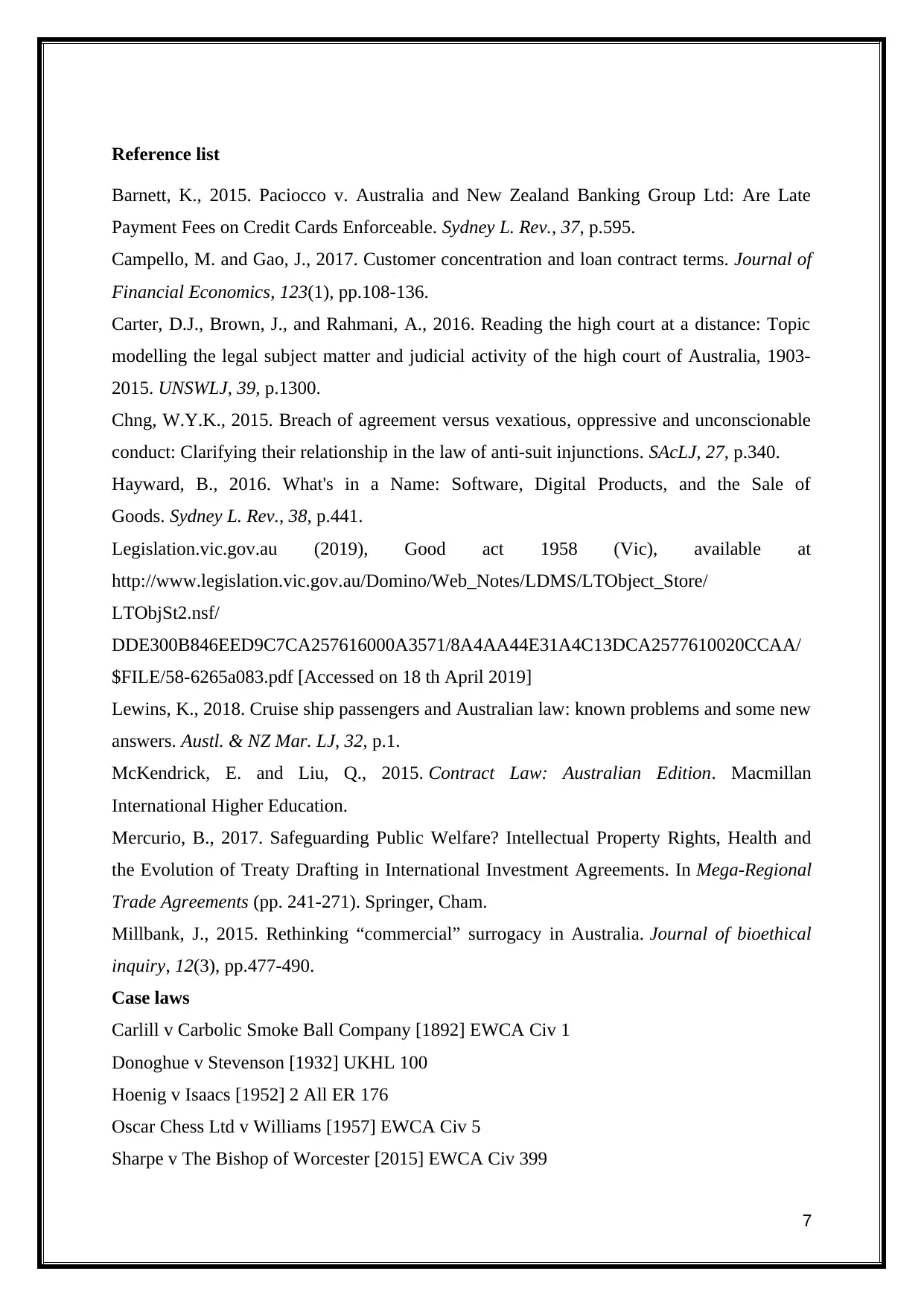
Reference list
Barnett, K., 2015. Paciocco v. Australia and New Zealand Banking Group Ltd: Are Late
Payment Fees on Credit Cards Enforceable. Sydney L. Rev., 37, p.595.
Campello, M. and Gao, J., 2017. Customer concentration and loan contract terms. Journal of
Financial Economics, 123(1), pp.108-136.
Carter, D.J., Brown, J., and Rahmani, A., 2016. Reading the high court at a distance: Topic
modelling the legal subject matter and judicial activity of the high court of Australia, 1903-
2015. UNSWLJ, 39, p.1300.
Chng, W.Y.K., 2015. Breach of agreement versus vexatious, oppressive and unconscionable
conduct: Clarifying their relationship in the law of anti-suit injunctions. SAcLJ, 27, p.340.
Hayward, B., 2016. What's in a Name: Software, Digital Products, and the Sale of
Goods. Sydney L. Rev., 38, p.441.
Legislation.vic.gov.au (2019), Good act 1958 (Vic), available at
http://www.legislation.vic.gov.au/Domino/Web_Notes/LDMS/LTObject_Store/
LTObjSt2.nsf/
DDE300B846EED9C7CA257616000A3571/8A4AA44E31A4C13DCA2577610020CCAA/
$FILE/58-6265a083.pdf [Accessed on 18 th April 2019]
Lewins, K., 2018. Cruise ship passengers and Australian law: known problems and some new
answers. Austl. & NZ Mar. LJ, 32, p.1.
McKendrick, E. and Liu, Q., 2015. Contract Law: Australian Edition. Macmillan
International Higher Education.
Mercurio, B., 2017. Safeguarding Public Welfare? Intellectual Property Rights, Health and
the Evolution of Treaty Drafting in International Investment Agreements. In Mega-Regional
Trade Agreements (pp. 241-271). Springer, Cham.
Millbank, J., 2015. Rethinking “commercial” surrogacy in Australia. Journal of bioethical
inquiry, 12(3), pp.477-490.
Case laws
Carlill v Carbolic Smoke Ball Company [1892] EWCA Civ 1
Donoghue v Stevenson [1932] UKHL 100
Hoenig v Isaacs [1952] 2 All ER 176
Oscar Chess Ltd v Williams [1957] EWCA Civ 5
Sharpe v The Bishop of Worcester [2015] EWCA Civ 399
7
Barnett, K., 2015. Paciocco v. Australia and New Zealand Banking Group Ltd: Are Late
Payment Fees on Credit Cards Enforceable. Sydney L. Rev., 37, p.595.
Campello, M. and Gao, J., 2017. Customer concentration and loan contract terms. Journal of
Financial Economics, 123(1), pp.108-136.
Carter, D.J., Brown, J., and Rahmani, A., 2016. Reading the high court at a distance: Topic
modelling the legal subject matter and judicial activity of the high court of Australia, 1903-
2015. UNSWLJ, 39, p.1300.
Chng, W.Y.K., 2015. Breach of agreement versus vexatious, oppressive and unconscionable
conduct: Clarifying their relationship in the law of anti-suit injunctions. SAcLJ, 27, p.340.
Hayward, B., 2016. What's in a Name: Software, Digital Products, and the Sale of
Goods. Sydney L. Rev., 38, p.441.
Legislation.vic.gov.au (2019), Good act 1958 (Vic), available at
http://www.legislation.vic.gov.au/Domino/Web_Notes/LDMS/LTObject_Store/
LTObjSt2.nsf/
DDE300B846EED9C7CA257616000A3571/8A4AA44E31A4C13DCA2577610020CCAA/
$FILE/58-6265a083.pdf [Accessed on 18 th April 2019]
Lewins, K., 2018. Cruise ship passengers and Australian law: known problems and some new
answers. Austl. & NZ Mar. LJ, 32, p.1.
McKendrick, E. and Liu, Q., 2015. Contract Law: Australian Edition. Macmillan
International Higher Education.
Mercurio, B., 2017. Safeguarding Public Welfare? Intellectual Property Rights, Health and
the Evolution of Treaty Drafting in International Investment Agreements. In Mega-Regional
Trade Agreements (pp. 241-271). Springer, Cham.
Millbank, J., 2015. Rethinking “commercial” surrogacy in Australia. Journal of bioethical
inquiry, 12(3), pp.477-490.
Case laws
Carlill v Carbolic Smoke Ball Company [1892] EWCA Civ 1
Donoghue v Stevenson [1932] UKHL 100
Hoenig v Isaacs [1952] 2 All ER 176
Oscar Chess Ltd v Williams [1957] EWCA Civ 5
Sharpe v The Bishop of Worcester [2015] EWCA Civ 399
7
Paraphrase This Document
Need a fresh take? Get an instant paraphrase of this document with our AI Paraphraser
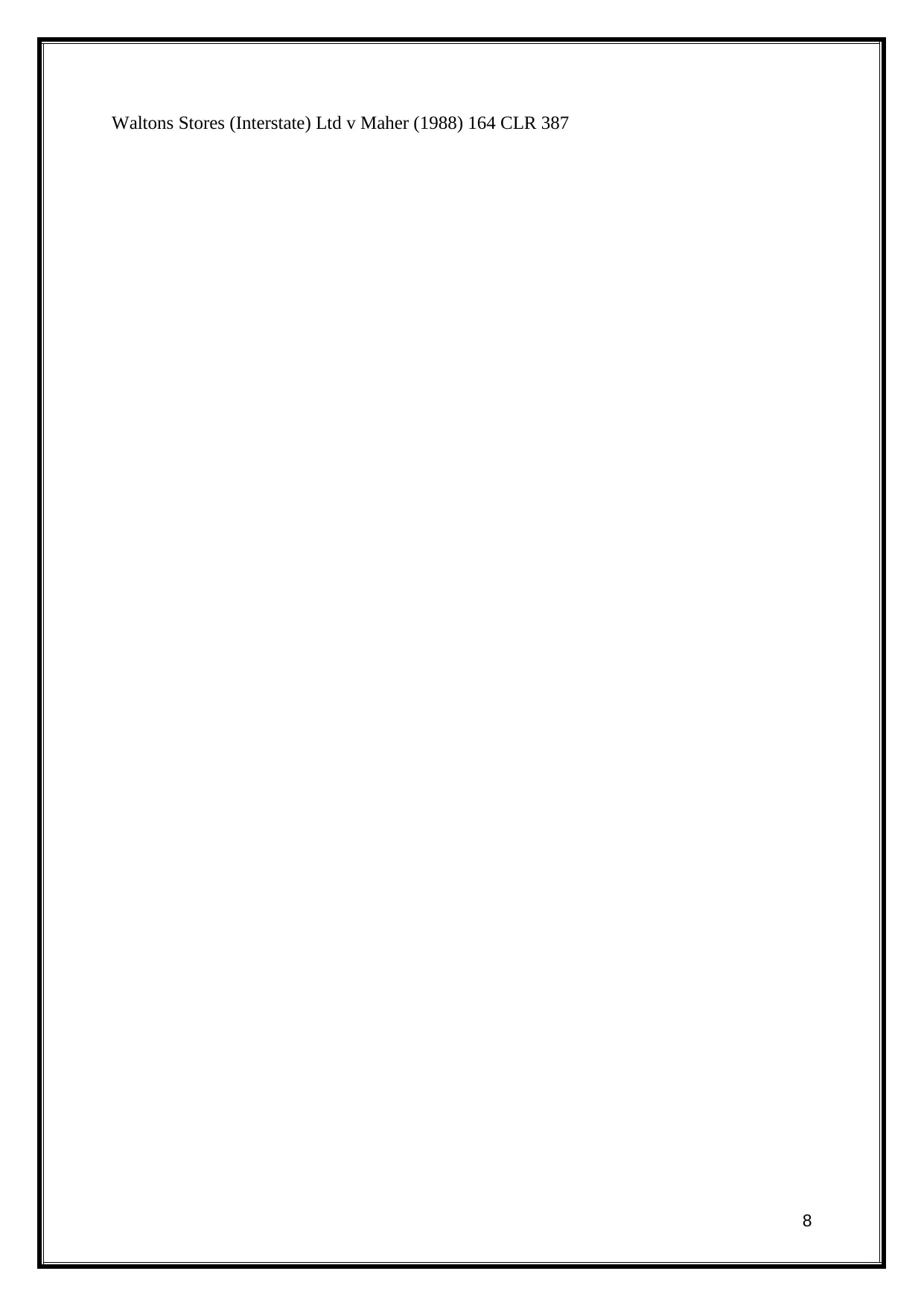
Waltons Stores (Interstate) Ltd v Maher (1988) 164 CLR 387
8
8
1 out of 8
Related Documents
Your All-in-One AI-Powered Toolkit for Academic Success.
+13062052269
info@desklib.com
Available 24*7 on WhatsApp / Email
![[object Object]](/_next/static/media/star-bottom.7253800d.svg)
Unlock your academic potential
Copyright © 2020–2025 A2Z Services. All Rights Reserved. Developed and managed by ZUCOL.



